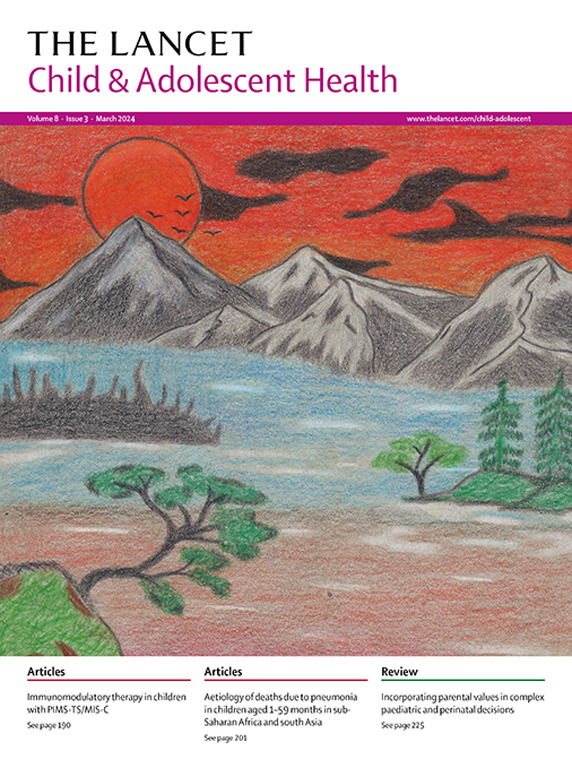儿童中风血管内血栓切除术(Save ChildS Pro):一项国际多中心前瞻性登记研究。
IF 19.9
1区 医学
Q1 PEDIATRICS
引用次数: 0
摘要
背景:新的证据表明,血管内血栓切除术有利于治疗儿童中风,但血管内血栓切除术的安全性和有效性尚未与最佳药物治疗进行比较。我们旨在前瞻性地分析血管内血栓切除术与最佳药物治疗对颅内动脉闭塞性卒中儿童的功能性结果:在这项前瞻性登记研究中,亚洲、澳大利亚、欧洲、北美洲和南美洲 12 个国家的 45 个中心报告了年龄在 28 天至 18 岁之间、由大血管或中血管闭塞引起的动脉缺血性卒中患儿接受血管内血栓切除术加最佳医疗方法或仅接受最佳医疗方法的功能结果。静脉溶栓被认为是最佳医疗方法的一部分,因此两组患者均可接受。主要研究结果是基线(中风前)与中风后90天(±10天)的中位改良Rankin量表(mRS)评分的差异,采用Wilcoxon秩检验进行评估(α=0-05)。在使用倾向得分匹配法进行的敏感性分析中,比较了血管内血栓切除术组和最佳药物治疗组的疗效。Save ChildS Pro研究已在德国临床试验注册中心(DRKS00018960.Findings)注册:2020年1月1日至2023年8月31日期间,在Save ChildS Pro登记的241名患者中,有208名纳入了分析(115名[55%]男孩和93名[45%]女孩)。117名患者接受了血管内血栓切除术(中位年龄为11岁[IQR 6-14岁]),91名患者接受了最佳药物治疗(6岁[3-12岁];p解释:临床中心倾向于选择中风程度更严重(PedNIHSS评分更高)的儿童进行血管内血栓切除术。尽管如此,与最佳药物治疗相比,血管内血栓切除术仍能改善大血管或中血管闭塞儿科患者的功能预后。未来的研究需要调查血管内血栓切除术的积极作用是否仅限于年龄较大和病情较重的儿童:无。本文章由计算机程序翻译,如有差异,请以英文原文为准。
Endovascular thrombectomy for childhood stroke (Save ChildS Pro): an international, multicentre, prospective registry study
Background
Emerging evidence suggests that endovascular thrombectomy is beneficial for treatment of childhood stroke, but the safety and effectiveness of endovascular thrombectomy has not been compared with best medical treatment. We aimed to prospectively analyse functional outcomes of endovascular thrombectomy versus best medical treatment in children with intracranial arterial occlusion stroke.
Methods
In this prospective registry study, 45 centres in 12 countries across Asia and Australia, Europe, North America, and South America reported functional outcomes for children aged between 28 days and 18 years presenting with arterial ischaemic stroke caused by a large-vessel or medium-vessel occlusion who received either endovascular thrombectomy plus best medical practice or best medical treatment alone. Intravenous thrombolysis was considered part of best medical treatment and therefore permitted in both groups. The primary outcome was the difference in median modified Rankin Scale (mRS) score between baseline (pre-stroke) and 90 days (±10 days) post-stroke, assessed by the Wilcoxon rank test (α=0·05). Efficacy outcomes in the endovascular thrombectomy and best medical treatment groups were compared in sensitivity analyses using propensity score matching. The Save ChildS Pro study is registered at the German Clinical Trials Registry, DRKS00018960.
Findings
Between Jan 1, 2020, and Aug 31, 2023, of the 241 patients in the Save ChildS Pro registry, 208 were included in the analysis (115 [55%] boys and 93 [45%] girls). 117 patients underwent endovascular thrombectomy (median age 11 years [IQR 6–14]), and 91 patients received best medical treatment (6 years [3–12]; p<0·0001). The median Pediatric National Institutes of Health Stroke Scale (PedNIHSS) score on admission was 14 (IQR 10–19) in the endovascular thrombectomy group and 9 (5–13) in the best medical treatment group (p<0·0001). Both treatment groups had a median pre-stroke mRS score of 0 (IQR 0–0) at baseline. The change in median mRS score between baseline and 90 days was 1 (IQR 0–2) in the endovascular thrombectomy group and 2 (1–3) in the best medical treatment group (p=0·020). One (1%) patient developed a symptomatic intracranial haemorrhage (this patient was in the endovascular thrombectomy group). Six (5%) patients in the endovascular thrombectomy group and four (5%) patients in the best medical treatment group had died by day 90 (p=0·89). After propensity score matching for age, sex, and PedNIHSS score at hospital admission (n=79 from each group), the change in median mRS score between baseline and 90 days was 1 (IQR 0–2) in the endovascular thrombectomy group and 2 (1–3) in the best medical treatment group (p=0·029). Regarding the primary outcome for patients with suspected focal cerebral arteriopathy, endovascular thrombectomy (n=18) and best medical treatment (n=33) showed no difference in 90-day median mRS scores (2 [IQR 1–3] vs 2 [1–4]; p=0·074).
Interpretation
Clinical centres tended to select children with more severe strokes (higher PedNIHSS score) for endovascular thrombectomy. Nevertheless, endovascular thrombectomy was associated with improved functional outcomes in paediatric patients with large-vessel or medium-vessel occlusions compared with best medical treatment. Future studies need to investigate whether the positive effect of endovascular thrombectomy is confined to older and more severely affected children.
Funding
None.
求助全文
通过发布文献求助,成功后即可免费获取论文全文。
去求助
来源期刊

Lancet Child & Adolescent Health
Psychology-Developmental and Educational Psychology
CiteScore
40.90
自引率
0.80%
发文量
381
期刊介绍:
The Lancet Child & Adolescent Health, an independent journal with a global perspective and strong clinical focus, presents influential original research, authoritative reviews, and insightful opinion pieces to promote the health of children from fetal development through young adulthood.
This journal invite submissions that will directly impact clinical practice or child health across the disciplines of general paediatrics, adolescent medicine, or child development, and across all paediatric subspecialties including (but not limited to) allergy and immunology, cardiology, critical care, endocrinology, fetal and neonatal medicine, gastroenterology, haematology, hepatology and nutrition, infectious diseases, neurology, oncology, psychiatry, respiratory medicine, and surgery.
Content includes articles, reviews, viewpoints, clinical pictures, comments, and correspondence, along with series and commissions aimed at driving positive change in clinical practice and health policy in child and adolescent health.
 求助内容:
求助内容: 应助结果提醒方式:
应助结果提醒方式:


